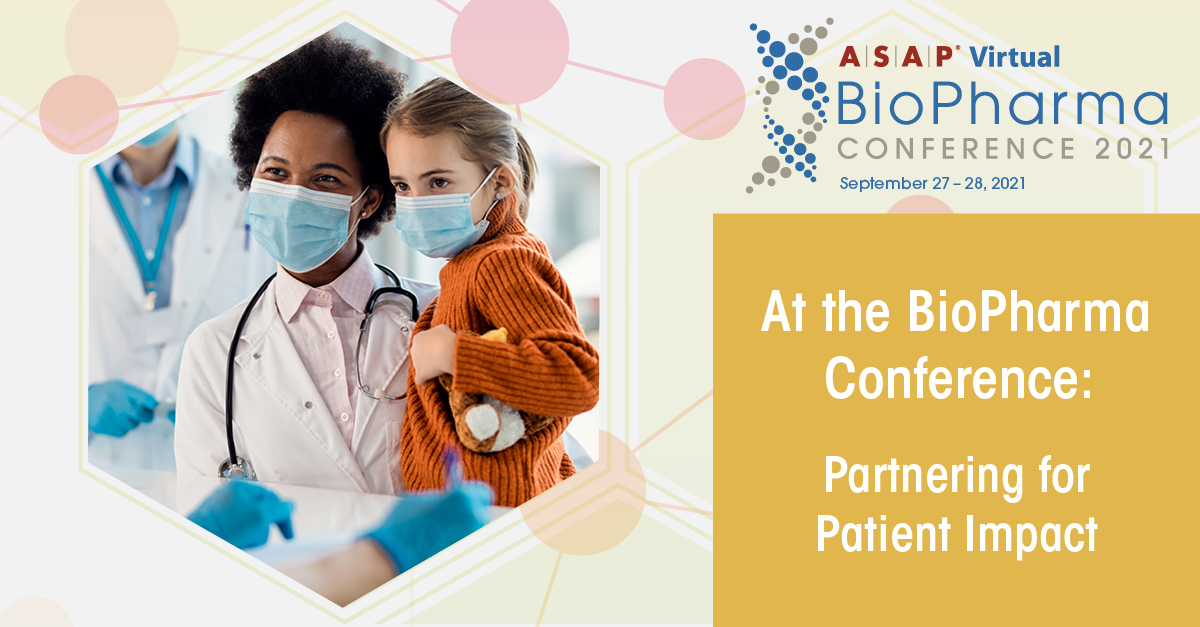Alliance Management Takes Aim at Improving the Life of the Patient
In recent years, the pharmaceutical industry has made it a point to have an intimate relationship with patients and incorporate the patient perspective into everything it does. Even functions like alliance management that haven’t traditionally been thought of as having a direct effect on patient outcomes are starting to realize that they can indeed influence the patient experience for the better.
In a session titled “Partnering for Patient Impact,” the 2021 ASAP BioPharma Conference convened a panel of pharmaceutical alliance management veterans to talk about some of the ways alliance managers can create a patient-focused culture across their portfolios, measure the impact alliances have on patients, and foster innovations that can directly improve patient experiences and outcomes.
Moderator Christine Carberry, CSAP, who now consults with biopharma startups looking to build alliance and program management capabilities after a decorated career that included stops at Biogen Idec and a few biotech startups, led the discussion off by tackling the first of these objectives.
The Patient’s Plight Is Real, Not a Tagline
Jeremy Ahouse, CSAP, PhD, vice president of alliances at clinical-stage immuno-oncology company Merus, N.V., acknowledged that it is easy to for people to take a cynical view of patient-centric missions. After all, “everyone says they’re patient focused,” he observed. Ahouse recommended having all parties meet patients in person in order to “keep [the patient mission] from becoming a tagline.”
In his view, once you hear the patient’s story, “it goes from being a hackneyed phrase to something that’s real.” In fact, Ahouse feels the patient’s plight can be a “leavening agent” when alliances get off track or parties start to encounter conflict.
Although it may sound a bit counterintuitive, it’s actually easy to forget the patient’s role when you are heads down in day-to-day laboratory activities. Chandra Ramanathan, PhD, global head of pharma R&D open innovation at Bayer, said it’s easy to “think [just] about assets” when you are working with small molecules, biologics, and other elements that go into the development of pipeline candidates. None of these things matter to the patient.
“They just want to feel better,” said Ramanathan.
All Activities Are Patient-Centric
But “patient-centricity” can and should be integrated into many, if not all, of the alliance function’s activities. Ramanathan gave the example of a Bayer collaboration around a new device that can help a segment of cardiovascular disease patients deal with fluid retention, a leading cause of heart-related hospitalizations. It’s important to realize that new devices, data-driven algorithms, and other newfangled innovations are improving the patient experience and saving lives.
Biopharma entities have so much R&D activity going on at any given moment. With every one of these initiatives, alliance managers should always ask, “Is it fundamentally innovative or disruptive? Patients help with that lens,” said Ramanathan.
Even with the right application of alliance management practices, the underlying science behind a project can fail, but according to Ramanathan the patient journey can inspire companies not to abandon ship on the overall mission, even when a particular project doesn’t succeed.
Advocacy Groups Help Convey Patients’ Trials
How do you put solving patients’ problems at the center of everything you do? Mark Coflin, CSAP, vice president and head of global alliance management at Simcere Group, has seen how his company’s stroke treatments have given patients better odds of evading serious incapacitation. He urged attendees to think about the patient’s needs when shaping clinical trials. Many alternate ways of conducting trials are emerging, but Coflin exhorted alliance managers and their research partners to “balance robustness and recruitment” and to really think through “what you’re asking your patient to do.”
Carberry added that if those conducting trials don’t make the patient’s life easier, recruitment efforts will hit a bump in the road.
“The most expensive patient is the one we don’t retain,” she said.
To this aim, a new stakeholder has emerged in the biopharma alliance ecosystem in recent years: the patient advocacy group. Ahouse said that these organizations have been instrumental in identifying patients with the specific ailments Merus’s oncology drug candidates tackle. He noted that there’s an inherent tension between patient advocacy groups and biopharma partners in that the latter are focused on their solution while the former “don’t care about our drug [necessarily].” Ahouse added that everyone tends to be more productive once this dynamic is acknowledged.
A few years ago, Bayer convened medical oncologists, policy specialists, and other stakeholders to compose a white paper on patient advocacy in cancer research. Based on Bayer’s activities with cancer research institutes since that time, Ramanathan conjectured that the “field could have transformed in a different way” if advocacy groups were involved two decades ago.
Making Patient Advocacy an Internal Mission
Coflin listed several ways the alliance group can incorporate patient advocacy internally, particularly in its interactions with business development. He recommended instituting a patient advocacy panel, incorporating the patient outcomes into the alliance charter and mission statement, and having patients join alliance meetings on occasion.
For cancer patients, it’s “a race against time,” he reminded the audience. “Every day counts.”
If you registered for this year’s ASAP BioPharma Conference but couldn’t join “Partnering for Patient Impact” live, don’t hesitate to retrieve the full discussion in the conference portal where you will learn how emerging data-driven alliances and real-world evidence (RWE) data are providing a picture of how patients react to drugs, and how collaborations with AI startups have the potential to make a dramatic improvement in the life of a patient. The conference continues tomorrow with more great sessions!

